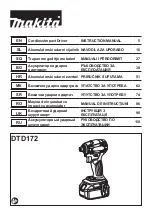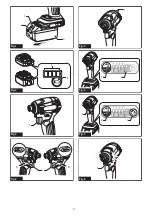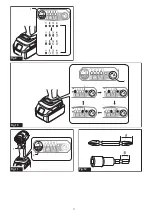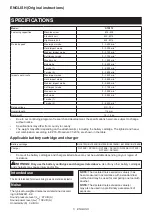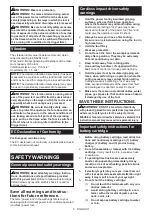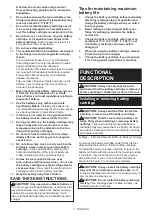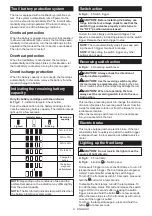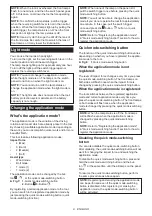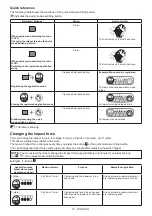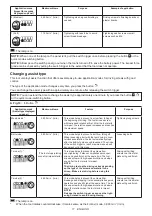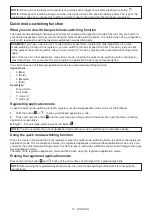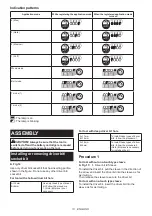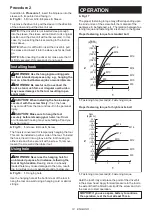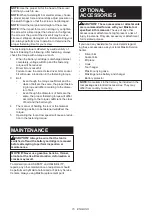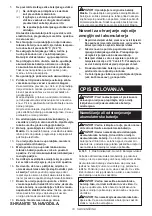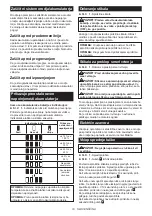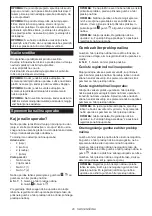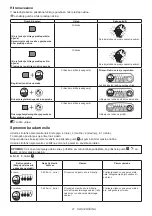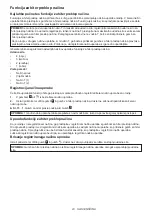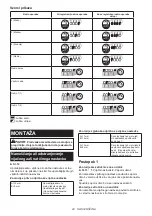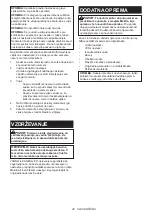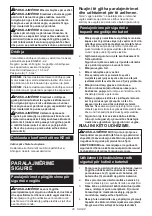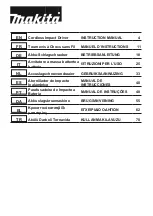
14 ENGLISH
Procedure 2
In addition to
Procedure 1
, insert the bit-piece into the
sleeve with its pointed end facing in.
►
Fig.14:
1.
Driver bit
2.
Bit-piece
3.
Sleeve
To remove the driver bit, pull the sleeve in the direction
of the arrow and pull the driver bit out.
NOTE:
If the driver bit is not inserted deep enough
into the sleeve, the sleeve will not return to its original
position and the driver bit will not be secured. In this
case, try re-inserting the bit according to the instruc
-
tions above.
NOTE:
When it is difficult to insert the driver bit, pull
the sleeve and insert it into the sleeve as far as it will
go.
NOTE:
After inserting the driver bit, make sure that it
is firmly secured. If it comes out, do not use it.
Installing hook
WARNING:
Use the hanging/mounting parts
for their intended purposes only, e.g., hanging the
tool on a tool belt between jobs or work intervals.
WARNING:
Be careful not to overload the
hook as too much force or irregular overburden
may cause damages to the tool resulting in per-
sonal injury.
CAUTION:
When installing the hook, always
secure it with the screw firmly.
If not, the hook
may come off from the tool and result in the personal
injury.
CAUTION:
Make sure to hang the tool
securely before releasing your hold.
Insufficient
or unbalanced hooking may cause falling off and you
may be injured.
►
Fig.15:
1.
Groove
2.
Hook
3.
Screw
The hook is convenient for temporarily hanging the tool.
This can be installed on either side of the tool. To install
the hook, insert it into a groove in the tool housing on
either side and then secure it with a screw. To remove,
loosen the screw and then take it out.
Using hole
WARNING:
Never use the hanging hole for
unintended purpose, for instance, tethering the
tool at high location.
Bearing stress in a heavily
loaded hole may cause damages to the hole, result
-
ing in injuries to you or people around or below you.
►
Fig.16:
1.
Hanging hole
Use the hanging hole at the bottom rear of the tool to
hang the tool on a wall using a hanging cord or similar
strings.
OPERATION
►
Fig.17
The proper fastening torque may differ depending upon
the kind or size of the screw/bolt, the material of the
workpiece to be fastened, etc. The relation between fas-
tening torque and fastening time is shown in the figures.
Proper fastening torque for standard bolt
N•m
(kgf•cm)
M14
M12
M10
M8
M16
M14
M12
M10
M8
M16
140
(1428)
(1224)
(1020)
(816)
(612)
(408)
(204)
120
100
80
60
40
20
0
1
2
1
2
1.
Fastening time (second)
2.
Fastening torque
Proper fastening torque for high tensile bolt
2
1
M14
M12
M14
M12
M10
M8
M10
M8
200
180
160
140
120
100
80
60
40
20
0
1
2
3
(2040)
(1836)
(1632)
(1428)
(1224)
(1020)
(816)
(612)
(408)
(204)
N•m
(kgf•cm)
1.
Fastening time (second)
2.
Fastening torque
Hold the tool firmly and place the point of the driver bit
in the screw head. Apply forward pressure to the tool to
the extent that the bit will not slip off the screw and turn
the tool on to start operation.
NOTICE:
If you use a spare battery to continue
the operation, rest the tool at least 15 min.

